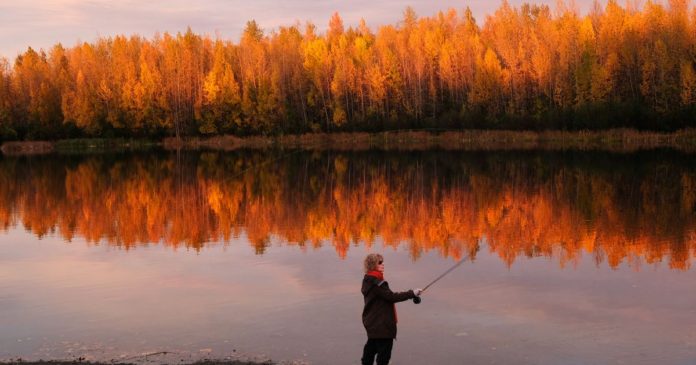An Alaska Flyfisher’s Odyssey: Seeking a Life of Drag-Free Drift in the Land of the Midnight Sun
By Daniel P. Hoffman, Sweetgrass Books, 192 pages, 2021. $22.95 (the author is donating 50% of his royalties to Trout Unlimited)
Winter has come early to Interior Alaska this year, and many outdoor enthusiasts are making the adjustment to the cold weather version of their favorite activities. Four wheel riders are tuning up their snowmachines, cyclists are dusting off their fat bikes, skiers can soon quit riding on rollers over pavement and return to gliding on snow. Fly fishers, however, are out of luck. It’s just about over for them until next spring, which is a very long ways away.
Daniel Hoffman knows this pain too well. In his recent memoir, “An Alaska Flyfisher’s Odyssey,” he begins his story in his home in the hills outside of Fairbanks, looking out over the Tanana Valley as the sun finally rises sometime around 11 on a December morning, while he’s stuck with memories of summers gone by and dreams of the one to come. In a state locked in ice for more than half the year, he picked a hobby that demands running rivers. But as he moves into summer, he makes it clear to readers that the fly fishing Alaska offers in that limited window of warmth makes up for the wait.
Hoffman is best known for his tenure as city police chief for Fairbanks. During that time in a job that invites controversy by its very existence, he managed to earn wide regard in the community with his calm demeanor and readiness amidst controversies to listen first and respond thoughtfully, rather than try to steer the dialog in his own chosen direction. (In the interest of full disclosure, I will note that I recently interviewed Hoffman for a profile piece, but beyond this do not know him; he gained my respect years ago when the city was faced with a public safety issue that he approached as a community member who happened to be police chief and not the other way around.)
With this memoir, which barely touches on his policing career, we find out where he developed this skill. He’s been a fly fisherman since childhood, and it’s instilled important lessons that have spilled over into his personal and professional life. Pay attention to what’s going on, don’t overreact and look for the drag-free drift.
Sporting memoirs can be treacherous to write. For those who share the passion for a particular activity, they can be spectacular fun. But for everyone else they need to offer more than just accounts of those memorable moments doing what one loves best. Spend too much time on, say, how to tie a fly, and those unacquainted with the sport can quickly lose interest. Ruminate on heavier matters for too long, and some of the more rabid fisherpersons are going to quit the book in a huff. The trick is to convey one’s enthusiasm for the sport in an infectious way that has broader applications. Do that and you’re golden.
For the most part, Hoffman pulls this off. I haven’t cast a fly rod since college in the early 1980s, and didn’t do it well. But I am a relentless mountain biker, and more than a few times while reading this book I thought to myself “I totally get this,” because the underlying lessons cross over. Hoffman writes that a “fisherman always needs to be looking well beyond his own location on the water, often times several yards up or downstream, in order to anticipate conditions and plan for the best course of action.” Anyone who’s ever sped down a narrow winding single track on a mountain bike knows this routine.
More importantly, though, Hoffman is using this as a metaphor for life. When he writes about achieving a drag-free drift, whether with a fly or in everyday routines, he doesn’t mean just going with the flow. The latter can send you into a snag and lead to a tangled mess in short order. A drag-free drift requires knowing your surroundings, anticipating problems before they arise, being alert to the unexpected, making constant adjustments to minimize interference even while taking calculated risks, and keeping the drift where you want it. This is as applicable to daily life as to fishing, he explains. There’s a Taoist element to this.
Hoffman is a genial guide with a gentle sense of humor who keeps the book moving along briskly. On occasion his narrative wanders a bit, but the for the most part he stays focused as he works his way through personal history, fishing adventures, and his thoughts on how thousands of hours with a fly rod have helped him keep his life in balance.
The opening section of the book contains four brief chapters detailing the seasons of Interior Alaska, describing how the region looks during each, how the climate feels to be out and about in, and even, in fall, how the Interior smells. He describes the scent of ripening cranberries as “Slightly nauseating in its first fecal impressions, its peculiar odor somehow becomes increasingly satisfying as one wanders our birch-covered hills.” I’d only add that it becomes ever more beloved with each passing year.
Hoffman provides plenty of fishing stories, but they take place within an Alaska he knows well. He was raised in a family where everyone fished, both for the love of being outdoors, and to fill the larder. His parents moved the family to Alaska when he was 12 and he’s never left. He credits his family for bringing him north and for helping him find his way through life.
One of Hoffman’s favorite places to fish is Katmai, but he bypasses the combat salmon fishing and heads upstream to catch and release trout instead. And to revel in the beauty surrounding him. And herein lies the reason this book works. It’s not a fly fishing in Alaska book. It’s a book about Alaska and about life that uses fly fishing in Alaska as its launching pad. The fishing stories are good, but they highlight the broader themes. Treasure this place. Find your pathway. Learn from it.
Credit: Source link































